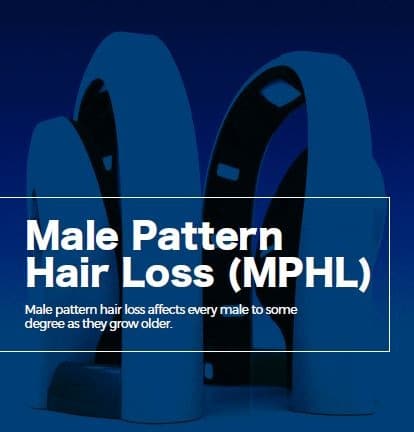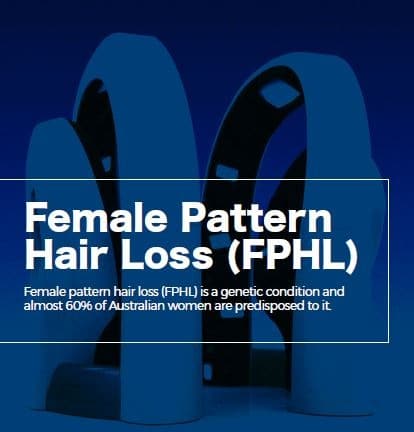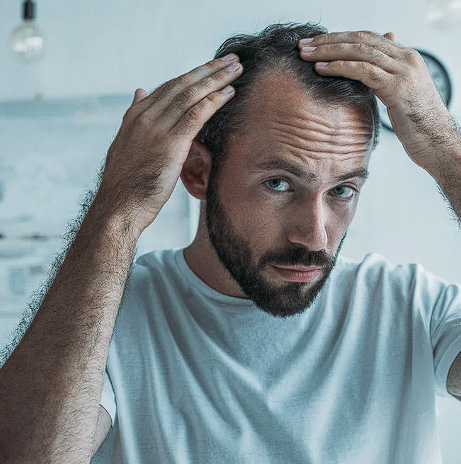What is hair loss?
The average person can lose as many as 100 hairs per day. Excessive hair loss (also known as alopecia) affects men and women. Hair loss can be widespread or patchy and can be caused by genetic conditions, disorders or diseases. If hair loss is severe or premature, it can cause distress.
The most common cause of hair loss in men is male pattern baldness (androgenic alopecia) and is a result of hormonal and genetic factors. Hereditary baldness is so common that many people see it as part of the ageing process.
If you start to notice significant hair loss or hair thinning, consult a dermatologist to see if the cause and available treatments can be identified. Hair loss treatments can reduce, slow, and stimulate partial hair regrowth.
How does hair grow?
Hair follicles cover all parts of your body except the soles of your feet, palms of your hands and lips. Hair is made from a protein called keratin, which grows, rests and renews. Your hair follicles are skin cells that contain the hair root. Many of these hairs don’t grow long enough to extend from the pore.
Your follicle supplies nutrients and oxygen to the hair root as it lubricates your hair with sebum. The root of your hair is attached to the base of the follicle. It’s the only living part of your hair.
Causes of hair loss
Hair loss (alopecia) can be caused by a number of factors and conditions. Some people can experience temporary hair loss (telogen effluvium) while others experience long-term hair loss.
Several genes in your mother’s and father’s family determine your susceptibility to hair loss. Genetic factors play a bigger role in hair loss than environmental factors. Studies show that identical twins lose their hair in the same pattern, at the same rate and at the same age. Androngenetic hair loss is caused by androgen hormones and occurs in people with a genetic susceptibility.
Other causes of hair loss include:
- Alopecia Areata: An autoimmune condition with an unknown cause that leads to patchy hair loss on the scalp.
- Alopecia Totalis: An autoimmune condition with an unknown cause that leads to loss of all hair on the scalp.
- Alopecia Universalis: An autoimmune condition with an unknown cause that leads to loss of all hair on the body and scalp.
- Disease: Including cancer,diabetes, and lupus
- Hair styling: Can cause hair loss if hair is excessively styled, straightened or brushed. Hair loss can also occur because of dying, bleaching or perming treatments.
- Hormonal changes or imbalances:This may occur during pregnancy, birthing, discontinuing use of birth control medication or devices that affect hormones, the onset of menopause, thyroid conditions, or severe emotional trauma and shock.
- Hyperhidrosis: This condition causes excessive sweating that can lead to lactic acid secretion harming the scalp and hair.
- Infections: Tinea capitis (ringworm of the scalp) is a contagious fungal infection that can cause patches of hair loss.
- Medical treatments: Radiation therapy and chemotherapy for cancer can cause hair loss.
- Medications: Medications including Accutane, blood thinners, anti-inflammatories, anti-fungals, drugs used to treat depression, high blood pressure, ulcers, thyroid disorders, Parkinson’s, heart disease, gout, glaucoma, epilepsy, cholesterol can lead to hair loss.
- Nutritional deficiencies: Hair loss can be caused by unhealthy dieting, eating disorders, or poor nutrition,
- Traction alopecia: This condition occurs when the scalp is scarred, and hair roots are damaged from over styling or pulling hair too tightly in hairstyles like ponytails, braids, or pigtails.
- Trichotillomania:This psychological disorder causes people to compulsively pull out their hair from the scalp, brows, or elsewhere on their body.
Hair loss in men
Androgenic alopecia can affect both men and women. It’s commonly known as male pattern baldness or female pattern baldness. This hereditary genetic condition can cause hair loss to occur in teenage years.
Androgenic alopecia develops because of:
- A genetic predisposition,
- The ageing process, and
- The presence of hormones and corresponding receptors.
Hair loss and baldness in men is a result of the male sex hormone DHT triggering hair follicles to shrink over time (follicular miniaturization) and stop growing new hair. Men typically experience hair loss at the crown and hairline, which extends around the back and side of the head, creating a horseshoe hair shape.
Hair loss in women
Androgenic alopecia can trigger female pattern baldness. The same sex hormone (DHT) that activates male pattern baldness also activates female pattern baldness.
Hair loss in women produces a scattered thinning over the top of the scalp instead of a bald spot, with the hairline being maintained. Over 55% of women experience minor hair loss as they age. Moderate to severe hair loss is experienced by about 20% of women.
Types of hair disorders
The 4 broad categories of hair loss include:
- Hair loss (alopecia)
- Excess hair (hirsutism)
- Hair infections
- Hair shaft disorders
Why Choose Sinclair Dermatology?
 Leader in skin and hair loss treatment and research
Leader in skin and hair loss treatment and research More than 50% of dermatology research papers in Australia are published by our team
More than 50% of dermatology research papers in Australia are published by our team Largest dermatology clinical trial research centre in Australia
Largest dermatology clinical trial research centre in Australia Only medical centre in Australia to use 3D whole body imaging technology to map moles and lesions for skin cancer detection.
Only medical centre in Australia to use 3D whole body imaging technology to map moles and lesions for skin cancer detection. Onsite pathology and compounding pharmacy
Onsite pathology and compounding pharmacy Our dermal clinic uses state of the art laser machines
Our dermal clinic uses state of the art laser machines
Our Clinics
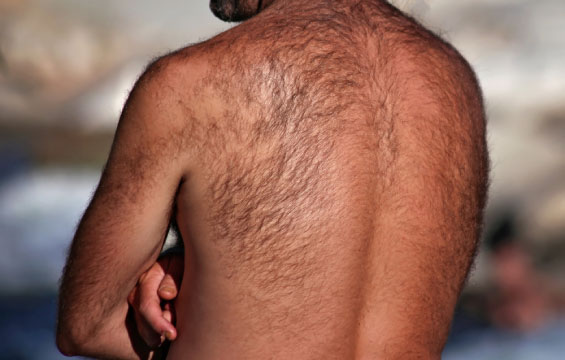
Excess Hair (Hirsutism)
Sinclair Dermatology provides services for removing unwanted or excessive facial or body hair.
We use medical grade hair removal laser machine that is operated by medically trained staff.
Laser hair removal is considered to result in permanent hair reduction and each laser appointment go for no longer than 30 minutes.
Excess hair (hirsutism) in women is characterised by the growth of thick, dark hair in typically ‘male’ areas of the body including the back, chest and face. A common cause of this is polycystic ovarian syndrome (PCOS). In some cases, there may be a genetic reason behind developing PCOS. For other women, excess hair only occurs when they are overweight.
Hair infections
Hair infections are usually contagious and usually result in hair loss. Types of hair infections include:
- Demodex folliculorum infection: this parasite lives in the follicles of your scalp and face. A severe infection can cause irritation and inflammation.
- Folliculitis: depending on the severity and duration of this bacterial infection of the hair follicles, temporary or permanent hair loss can occur.
- Piedra: this fungal disease causes hard nodules to form along the hair shaft resulting in hair snapping off at the nodules.
- Ringworm: this fungal infection of the scalp typically starts as a small circle of red, itchy and scaly skin. As the ring grows, the hairs close to the scalp within its circumference snap off.
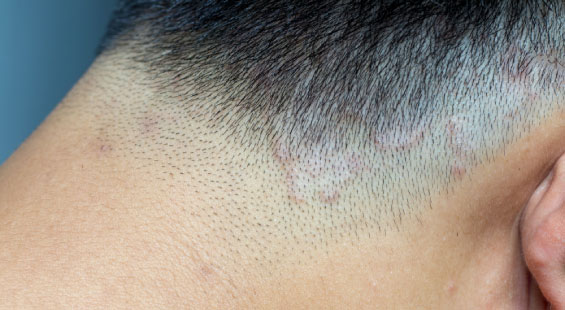
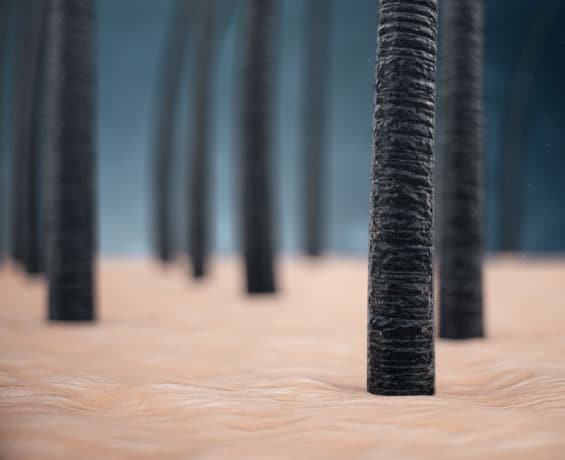
Hair shaft disorders
Hair shaft disorders are a result of inheriting faulty genes. This results in either unmanageable hair or hair loss. Types of hair shaft disorders include:
- Marie Unna hypotrichosis:this occurs when a child is born without scalp hair. They will grow coarse hair until pre-puberty until the hair falls out.
- Menkes syndrome:an inability to properly metabolise copper causes a range of problems including brittle and unpigmented hair.
- Monilethrix:usually only affecting the scalp, the nodules cause hair breakages.
- Pili torti:this condition causes patches of hair loss and hair stubble.
- Trichorrhexis invaginata: this hair disorder is also known as ‘bamboo hair’ where the hair shaft has abnormal nodules. Breakages of the hair occur at these weak points.
- Trichorrhexis nodosa:a condition where the cortex frays, splits and weakens the hair, which causes it to split and break off.
- Trichothiodystrophy: this hair disorder occurs when the hair shaft is brittle because of insufficient elements and proteins including sulphur and cystine.
- Uncombable hair syndrome: people with this hair disorder typically have silvery-blonde hair that is slow to grow, dry and unusually stiff.
- Woolly hair: this hair disorder appears in people with a non-African descent who have frizzy and tightly curled hair.
Treatments for hair loss
While there is no cure for hair loss, a number of treatments can slow or reduce hair loss, stimulate partial regrowth or replace damaged hair. Men with advanced balding find that surgical hair transplantation is beneficial.
Age-related hair loss and hereditary forms of hair loss are hard to reverse. Hair loss treatments can control alopecia areata and in some cases hair thinning stabilises so baldness can be avoided.
Cosmetic hair loss and alternative treatment options:
Some men and women who are experiencing hair loss discover that wearing wigs and hairpieces can help them feel like themselves again.
Other treatments suggested for hair loss include:
- Massage,
- Vitamin supplements,
- Herbal remedies like saw palmetto,
- Zinc,
- Amino acids,
- Hair lotions and
It’s important to note that none of the above treatments have been scientifically shown to prevent hair loss or promote hair growth. The use of laser therapy to prevent hair loss has no scientific evidence either. Consulting with your doctor before starting any hair loss treatment is the best course of action.
Male pattern baldness treatments (androgenic alopecia)
While there are a number of treatments available for male pattern baldness, it’s important to understand there is no known cure. Treatments include Minoxidil lotion and Finasteride tablets, which are available on prescription. Cosmetic options include camouflage sprays, wigs and hair transplantation procedures.
Hair loss in women (androgenetic alopecia)
A number of treatments are available for female pattern hair loss, including topical Minoxidil lotion (not recommended for pregnant or breastfeeding women) and tablets such as spironolactone, which have antiandrogen properties (they lower the levels of male hormones). These are available on prescription and require a doctor’s supervision.
Non-surgical hair loss treatments include lotions and tablets that can maintain regrowth. If you stop these hair loss treatments, the regrowth will cease, and your hair loss will start again.
Hair loss lotions include:
Minoxidil
This over the counter lotion is available at pharmacies and has been used for hair loss treatment since the 1970’s. Minoxidil (Rogaine) comes in drops or a foam preparation that needs to be applied in the morning and at night. It’s important to note that hair regrowth can take six months to appear. This lotion is not suitable to use if you have low blood pressure, you’re on high blood pressure medication, are pregnant or breastfeeding.
Hair loss tablets include:
Finasteride:
Since the late 1990’s, Finasteride (Propecia) has helped stop hair loss in over 90% of men. This prescription tablet is taken once a day and has stimulated hair regrowth in over two-thirds of men who have taken it. While regrowth is visible at 6 months, it can take 2 years for visible results. It’s important to note this treatment is only suitable for men. Finasteride can have sides effects such as affecting libido and can lead to erectile dysfunction and gynaecomastia.
Spironolactone:
Developed in the 1960’s this prescription medication is effective for women with hair loss as it blocks the effect of androgen hormones. These hormones lead to acne, oily skin, unwanted facial and body hair and hair loss on the scalp. This hair loss medication isn’t suitable for men, pregnant or breastfeeding women.
Cyproterone acetate:
Developed in the 1960’s this prescription medication will block the effect of androgen hormones. As a weak progesterone it’s also used in some oral contraceptives. Cyproterone acetate is effective at treating acne, unwanted body and facial hair and hereditary hair loss in women. This oral hair loss treatment is not suitable for men.
Hair transplantation procedures
Hair transplantation procedures use techniques that include micro-grafts, follicular unit transfer, and single unit transfers on patients who want a fuller, thicker head of hair. These hair transplantation techniques produce a much more natural appearance than older techniques of plug grafting. For optimal hair loss, multiple techniques can be used.
Find out more about hair transplantation options please visit our dedicated page here.
To book a consultation in our hair loss clinic please call us on 9654 2426 or email appointments@sinclairdermatology.com.au
Accreditations & Memberships






















